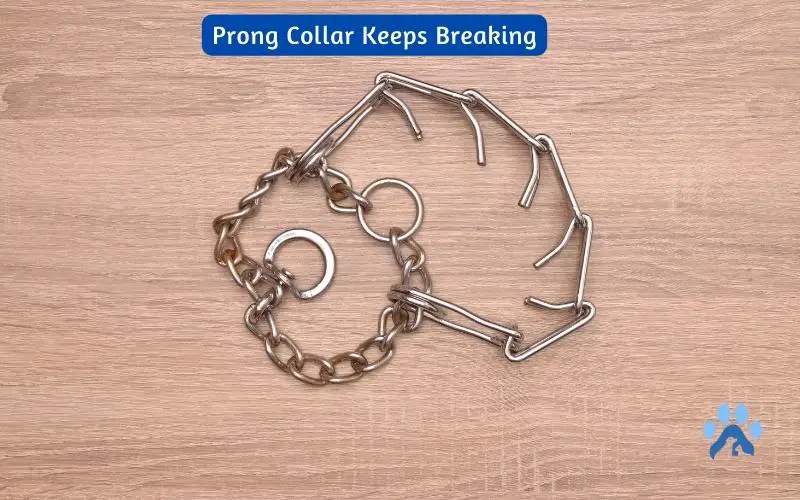As a pet owner, one of the most important tasks is ensuring that our pets are well-trained and well-behaved. While there are several training methods and techniques, an essential consideration for many is using a prong collar.
But unfortunately, prong collars are known to break or become worn out quickly. So, why does the prong collar keeps breaking?
This is often due to the stress placed on the collar when it is used to control the dog, as well as a lack of maintenance on the owner’s part. Poor quality materials can also be a factor, as can a failure to properly size the collar to the dog’s neck.
No matter the case, in this blog post, we will investigate these factors and find out how to prevent this.
Let’s get started.
Causes of Prong Collar Breakage
The most common cause of prong collar breakage is incorrect sizing. A prong collar should snugly but not painfully fit around your dog’s neck.
The collar can slide over your dog’s head or come off entirely if the collar is too loose. The prongs of the collar may break if it is excessively tight, which could irritate your dog’s skin.
Another common cause of prong collar breakage is rust. Rust can weaken the collar’s metal, causing the prongs to bend or break.
If you live in a humid climate or your dog often swims, check the collar regularly for signs of rust and replace it as needed.
Finally, prong collars can break if they’re misused. Never yank on the leash or use the collar to correct behavioral problems.
Doing so can damage the collar and injure your dog. However, when used correctly, a prong collar may be a secure and reliable training tool for dogs.
Consequences of Prong Collar Breakage
One of the most common consequences of prong collar breakage is injury. A broken collar can cause the metal prongs to dig into the dog’s skin, causing puncture wounds or abrasions.
In some cases, the metal prongs may even become embedded in the dog’s neck and require veterinary intervention.
In addition to physical injury, if a prong collar breaks, the dog may be able to get loose and run away, or worse, the broken ends of the collar could injure the dog’s neck.
If you suspect your prong collar has broken, it’s essential to replace it immediately to avoid these negative consequences.
Prevention of Prong Collar Breakage
Prong collars are effective for training dogs but can break if not used properly. Here are some tips to prevent and fix broken prong collars:
Don’t pull on the collar too hard or yank your dog’s neck. The prongs may become damaged if they are under too much pressure.
If you need to grab your dog’s collar quickly, use the leash instead of the collar itself. This will help prevent accidental breakage.
Inspect the collar regularly to ensure the prongs are not bent or damaged. If they are, replace the collar immediately.
If a prong does break, don’t panic! Simply remove the broken piece and continue using the collar as normal.
Quick and Easy Solutions
If your dog’s prong collar has broken, don’t worry – there are a few simple steps that can help you fix it quickly and easily. Here’s how you can go about repairing your prong collar and getting back to spending quality time with your pup:
Check for any sharp edges or points on the collar. If prongs have become bent or broken off, they may need to be replaced. Take the collar to a professional pet supply store for replacement parts, or look for them online.
Look for any missing links in the chain of the collar. If some of these are missing, it will cause the collar to lose its tension and prevent it from working effectively.
Again, you can buy replacement parts from a pet store or online or take them to a professional pet supply store specializing in collars and leashes.
Make sure the components are all tightly secured together. You may need to use pliers or other tools to ensure all links are firmly attached and won’t break apart when used on your dog.
Test your dog’s repaired collar before taking him outside for a walk. Ensure all the links are secure and that none move when you apply pressure to them while testing the collar’s fit on your pup’s neck.
Factors to Consider Before Fixing a Prong Collar
The difficulty of fixing a prong collar depends on several factors, including the type of prong collar you have and the collar’s condition.
It’s essential that you consider these before attempting any repairs, so you don’t put yourself or your pup at risk of injury or discomfort due to an ill-fitting or damaged product.
The Type of Prong Collar
The first factor to consider when attempting to fix a prong collar is the type of prongs used in its construction. There are two main types: standard and slip-on collars.
Standard prongs feature metal prongs that must be adjusted manually to make sure they fit snugly around your pup’s neck without causing any discomfort or irritation.
Slip-on collars feature plastic pieces that slide onto each end of the collar, allowing quick and easy adjustments without touching any metal parts. For those not comfortable adjusting metal components manually, slip-on collars may be preferable.
Condition of Your Prong Collar
The last factor to consider before fixing a prong collar is its condition. If your current one has become worn out or damaged over time due to wear and tear, it may be better off replaced with a brand new one rather than trying to fix it yourself.
Look closely at your existing prongs and examine them for any signs of rust or corrosion, which could indicate that they need replacing – if there is any sign of damage, then returning them should be done as soon as possible to prevent further damage from occurring.
Key Takeaway
All in all, prong collars may be the most effective way to train a dog, but it’s essential to make sure you buy one that’s the right size and of good quality.
If your prong collar keeps breaking, you are likely using the wrong size or a defective product. So, look for a brand that provides reliable collars with a warranty to ensure your dog’s safety. Training the dog to stop pulling can also be beneficial in the long run.
Frequently Asked Questions
Do prong collars break easily?
Prong collars are very durable and do not break easily. The metal used in quality prong collars is strong and rust-resistant. The metal prongs are often covered with plastic tips to help protect the dog’s skin.
When used correctly and not left on the dog when unsupervised, prong collars are a safe and effective tool in training.
What can I use instead of a prong collar?
There are many alternatives to traditional prong collars. Gentle Leader head collars are a great option and provide control without discomfort. These collars consist of two loops, one around the muzzle and one around the neck.
Another alternative to stop a dog from slipping out of the collar is a Martingale collar. Martingale collars are adjustable and provide even pressure when pulled, so the dog doesn’t experience discomfort.
Another popular option is the choke chain. Although this is not recommended for inexperienced dog owners, a properly fitted choke chain may be used for quick and effective correction.
Lastly, a standard buckle collar can be used for essential obedience work. The key is to ensure the collar is fitted correctly and not too tight.
What does Cesar Millan say about prong collars?
The famed Dog Whisperer, Cesar Millan, believes that prong collars should be used sparingly. Prong collars can be helpful in certain situations, such as when walking a powerful or strong-willed dog.
However, they should only be used with reward-based training methods, not as a punishment.
Are they banning prong collars?
To date, no nationwide ban on prong collars has been issued. However, several organizations, including the American Veterinary Society of Animal Behavior, have recommended that prong collars not be used due to the potential for harm.
Before making a choice, it is essential to consider the possible risks of using prong collars and assess the pros and drawbacks.
How do you secure a prong collar?
Securing a prong collar is essential for safe and effective use. First, ensure the collar is appropriate for your dog; it should fit snugly but not too tight.
Afterward, affix the collar to your dog’s neck and adjust it accordingly so that one or two fingers may fit between the skin and the collar very easily. Attach the leash and ensure it is firmly fastened when the collar is fastened.
Lastly, ensure the prongs are facing the dog’s body and there is no slack in the collar. If the coupling is tight enough, the prongs may not act as effectively as expected.



